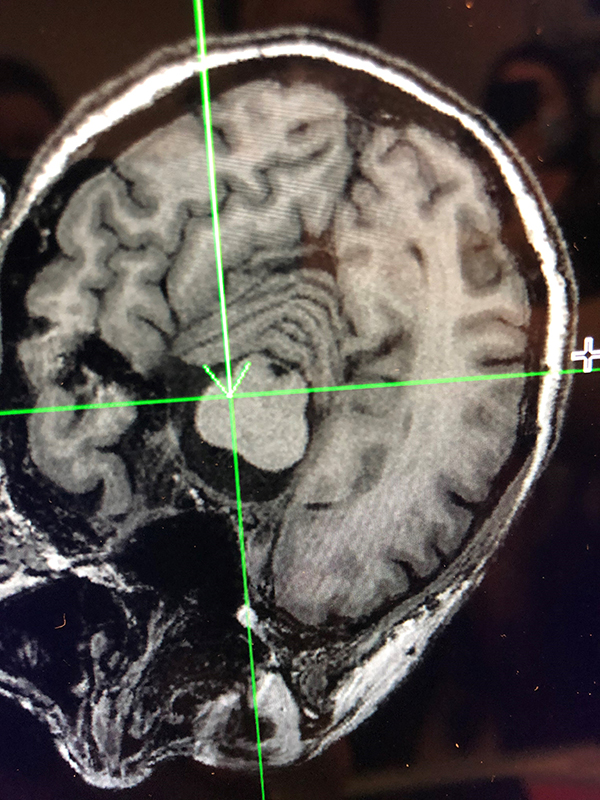Key Points
- Researchers at Columbia University are seeking patients for a clinical trial using focused ultrasound to facilitate the delivery of chemotherapy to progressive diffuse intrinsic pontine gliomas (DIPGs).
- DIPGs are a malignant type of brain tumor that affect children around the age of five.
- The study uses a novel neuro-navigational device designed and tested at Columbia.
 A team at Columbia University is seeking patients for a first-in-human clinical trial using focused ultrasound to facilitate the delivery of chemotherapy to progressive diffuse intrinsic pontine gliomas (DIPGs), a malignant type of brain tumor that affects children.
A team at Columbia University is seeking patients for a first-in-human clinical trial using focused ultrasound to facilitate the delivery of chemotherapy to progressive diffuse intrinsic pontine gliomas (DIPGs), a malignant type of brain tumor that affects children.
DIPGs are highly aggressive and devastating brain tumors that affect young children, typically around the age of five or six. As the tumors are located in critical areas of the brain and are known to infiltrate the surrounding tissue, surgical removal is impossible. There are no effective treatments for DIPGs, and only 10 percent of children survive two years after diagnosis.
Led by Stergios Zacharoulis, MD, the Herbert Irving Associate Professor of Pediatrics at Columbia University Medical Center, the phase I trial is assessing the safety and feasibility of using a novel focused ultrasound device to noninvasively and temporarily disrupt the blood-brain barrier (BBB) to allow increased amounts of chemotherapy to more effectively reach the brain tumor.
The BBB is a protective layer of tightly joined cells that lines the blood vessels in the brain and prevents harmful substances, such as toxins and infectious agents, from diffusing into the surrounding brain tissue. However, it can also prevent therapeutic agents – like chemotherapy – from getting into the brain in adequate concentrations to be effective. Focused ultrasound can be used to vibrate microbubbles in the vessels to temporarily open the tight junctions of the BBB, enabling higher concentrations of therapies to enter brain tissue.
“DIPG is the most devastating childhood cancer, and there has been absolutely no progress achieved despite decades of clinical trials,” says Dr. Zacharoulis. “It is time to entirely change the way we approach this disease, taking into consideration all the known biological obstacles. Our study is the first to address the essential issue of the BBB disruption in a noninvasive manner, allowing active drugs to at least reach their target.”
Up to 15 trial participants will receive focused ultrasound therapy and Definity® microbubbles alongside Panobinostat, a common oral chemotherapy, every other day for two weeks, followed by one week off. The treatments will be outpatient, meaning there is no overnight hospital stay required. In all, patients will undergo six treatment cycles.
Researchers will use MRI scans to assess the effectiveness of BBB opening and tumor response after focused ultrasound treatment. The team will also examine cell-free tumor DNA in the bloodstream – or liquid biopsy – to provide longitudinal follow up of the tumor. The laboratory work is being led by Dr. Cheng-Chia Wu, MD, PhD, Assistant Professor of Radiation Oncology at New York-Presbyterian/Columbia University Medical Center.
This study uses a novel device designed and tested at Columbia. Elisa Konofagou, PhD, the Robert and Margaret Hariri Professor of Biomedical Engineering and Radiology at Columbia University, and her research team at the Ultrasound Elasticity Imaging Laboratory (UEIL) created the device, which uses a single-element focused ultrasound transducer under neuronavigational guidance. The device is currently being used in another clinical trial for Alzheimer’s disease.
The trial is being co-funded by the Focused Ultrasound Foundation.
“Focused ultrasound can be especially beneficial for pediatric patients, because it is noninvasive and avoids ionizing radiation,” says Foundation Chairman Neal F. Kassell, MD. “The technology is being used in a number of pediatric applications, including benign brain tumors, bone tumors, and soft tissue tumors, such as sarcomas, neuroblastomas, and Wilms’ tumors. The Foundation is dedicated to advancing this technology and future research in the field to help these young patients.”
For Patients
To learn more about this clinical trial, please contact:
Stergios Zacharoulis, MD
212-305-9500
sz2764@cumc.columbia.edu
Chankrit Sethi, MPH
212-305-4030
cs3879@cumc.columbia.edu
